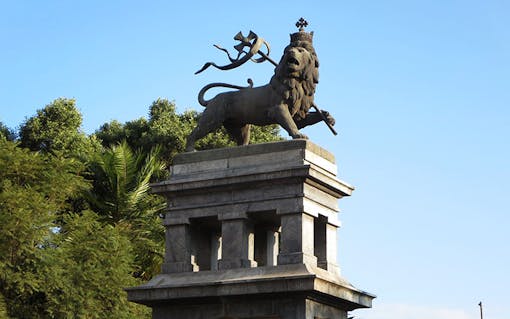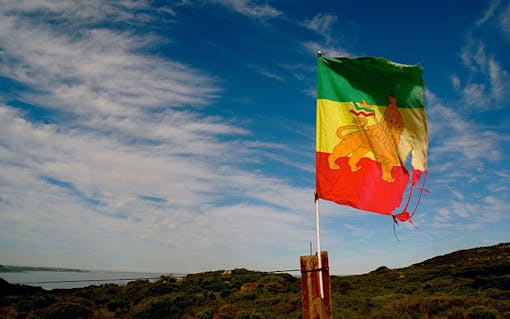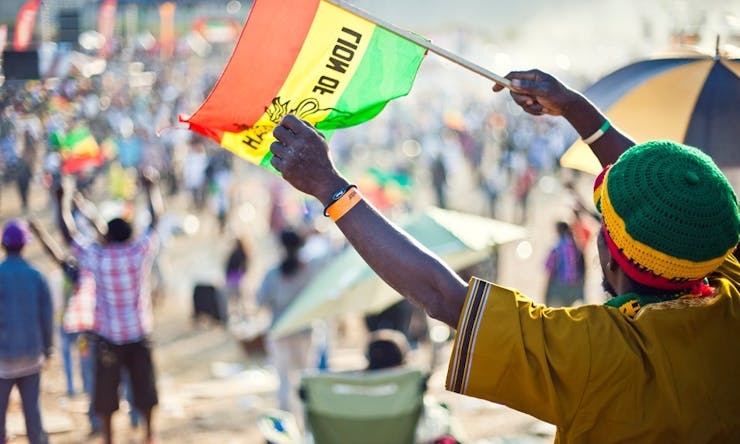As both symbol and beast, the lion has proven to be a source of fascination for man, woman, and child. The timeless awe in which human culture holds this animal can perhaps best be seen in the Ardèche Valley of Southern France. Here, within the Chauvet Cave, are walls which reveal how Paleolithic man lived roughly 32,000 years ago, portraying the animals he both hunted and lived alongside. This famed archaeological site is decorated with intricate paintings of bison, horses, mammoths, but most predominantly, lions.
Yet, despite this remarkable legacy and symbolic grandeur, lions are suffering extinction across Africa and India. Their numbers have dropped to the point where the species needs to be placed on the endangered list. Here at Leafly, we want to spread the word and acknowledge the magnificence of the lion in our own way: by exploring the cultural significance between the Rasta lion and cannabis.
Rastafarian Culture and Marijuana

Rastafarians, or Rastas, those who follow the Rastafarian movement, are synonymous with marijuana (or, as they might refer to it, ganja) in popular culture. It’s what immediately comes to mind when you hear the phrase, probably closely followed by dreadlocks, Jamaica, and Bob Marley.
The very first branch of Rastafari is believed to have been established in Jamaica in 1935 by Leonard P. Howell. His work, The Promise Key, published that year, is a Rastafari tract and contains many of the articles of faith on which the movement is built.
In 1933, Howell had begun to preach that Emperor Haile Selassie I of Ethiopia was the Messiah and that Africans were the chosen people who would soon be repatriated to Ethiopia. He believed that all African people would gain the superiority over whites that had always been intended for them. Howell’s actions encouraged others to develop and spread the message of Rasta theology.
Cannabis consumption has been culturally entrenched in the Rastafari movement since the 1930s but, despite what most might assume, the use of marijuana simply to get high is condemned by Rastafari. Actually, Rastafarians are opposed to drug use in general. They frequently avoid alcohol, tobacco, caffeine, and will not use cocaine or heroin. These substances are viewed as poisons that defile the body.
Ganja, however, is seen as a gateway to understanding. The Rastas’ use of ganja stems back to the beginning of Rastafari in Jamaica. In 1941, Howell set up a Rasta community of 1,600 Rastas named Pinnacle. At Pinnacle, Howell grew marijuana as a cash crop. It was during this time that Rastafarians discovered the properties of marijuana that helped to improve their reasoning sessions.
Turning to the Bible, Rastafarians found reverence within certain passages towards the use of this sacred weed, believing that the “Tree of Life” mentioned in the Bible is the marijuana plant and that several passages promote its use:
- “He causeth the grass for the cattle, and herb for the services of man” (Psalm 104:14)
- “Thou shalt eat the herb of the field” (Genesis 3:18)
- “Eat every herb of the land” (Exodus 10:12; note that this is part of a passage about God telling Moses to cast a plague of locusts)
- “The herb is the healing of the nations” (Revelation 22:2)
Subsequently, marijuana became embedded within the Rastafari culture. Rastas commonly gather together and smoke ganja from a shared pipe called a chalice during ritual gatherings known as reasoning sessions. These group meetings involve meditation where ideas are freely shared among participants. For Rastas, communal smoking helps to emphasize the sense of community as well as producing visions of a religious and calming nature.
Now that you’re familiar with Rastafarian culture, how does the king of the jungle feature so prominently? The answer is simply and, most explicitly, on the flag.
The Rasta Lion

The symbol of the lion is connected to Haile Selassie, an emperor of Ethiopia whom the Rastafarians worship as the Messiah. Rastafarians believe that Selassie’s lineage can be traced back to the Tribe of Judah, which itself used the lion as a symbol. Consequently, Rastafari refer to him as the Conquering Lion of the Tribe of Judah. They believed that Haile Selassie, as the inheritor of the lineage of the House of Solomon, was the Second Coming, and that he could return to Africa members of the black community who were living in exile as the result of colonization and the slave trade.
Rastafari theology developed in Jamaica during the 1930s from the ideas of Marcus Garvey, a political activist who wanted to improve the status of fellow blacks. Although Garvey never actually followed Rastafari or believed in it, he is considered to be one of the religion’s prophets as it would be his ideologies that eventually grew into Rastafarianism.
Garvey’s Pan-Africanism teachings of black self-empowerment are credited as being the sources behind the founding of the religion. He believed that all black people should return to their rightful homeland in Africa. Throughout the 1920s, Garvey would play a role in organizing the black nationalist movement in America. He taught people to be proud of their race, but he also offended other black leaders with his ideas of separatism within races.
His ability to perform powerful speeches would earn him millions of supporters. Indeed, many believe that what Garvey preached in 1920 became the statement upon which the foundation of the Rastafari movement would be laid:
“Look to Africa where a black king shall be crowned, he shall be your Redeemer”
However unlikely, this proclamation would be realized in 1930 when Ras Tafari Makonnen was crowned the new Emperor of Ethiopia to become known as Emperor Haile Selassie I.
Who (or What) is the Lion of Judah?

The Lion of Judah was depicted on the flag of Ethiopia from 1897 to 1974. Due to its association with Selassie, it continues to be an important symbol among members of the Rastafari movement. The prophesy of the coming of Haile Selassie I as the Messiah is predicted according to some by biblical references.
In Christianity, the Lion of Judah epithet is typically used to refer to Jesus Christ, but that’s not where the meaning of this symbol ends. The Lion of Judah is an ancient symbol, representing the Israelite tribe of Judah throughout the Old Testament of the Torah. It also features on the emblem of Jerusalem, in recognition of the original tribe of the Biblical Judah. Traditionally, the tribe is represented by a lion. The symbol dates back to the tribe’s patriarch Jacob, in the blessing he gives to Judah in the Book of Genesis, referring to him as a “lion’s cub” (Genesis 49:9).
The Bible reveals Jesus’ bloodline dating back to Jacob, of the House of David. Judah was Jacob’s fourth son who would become father of the Twelves Tribes of Israel. King David, an ancestor of Jesus, was also from Judah’s lineage. According to Judges 1:2, God chose the Tribe of Judah to take the lead in conquering the nations who were living in the land promised to the Twelve Tribes.
In speaking of the Tribe of Judah, Jacob said:
“Judah, you are he whom your brothers shall praise; your hand shall be on the neck of your enemies; your father’s children shall bow down before you. Judah is a lion’s whelp; from the prey, my son, you have gone up. He bows down, he lies down as a lion; and as a lion, who shall rouse him? The scepter shall not depart from Judah, nor a lawgiver from between his feet, until Shiloh comes; and to Him shall be the obedience of the people” (Genesis 49:8-10)
This prophecy claimed that in Israel the line of Kings would descend directly from Judah. When David succeeded the throne after the death of King Saul, the prophecy would be fulfilled. David’s descendants were the kings of the United Kingdom of Israel and Judah until the time of the Babylonian captivity in 586 BC.
According to the Kebra Negast, a 13th century treatise that is used to legitimize the Ethiopian dynasty, the Queen of Sheba would travel to King Solomon and give birth to a child by him named Menelik I. As Solomon was of the tribe of Judah, his son Menelik I would continue the line which, according to Ethiopian history, was passed directly down from king to king until the successful heave against Emperor Haile Selassie I in 1974.
As said, the would-be emperor could claim to trace his line back to Menelik I. Originally named Tafari Makonnen, he was the only legitimate son of Ras Makonnen. Among his father’s allies was his cousin, Emperor Menelik II, who did not have a male heir to succeed him.
In 1916, Tafari took power from Iyasu V and imprisoned him for life. The following year Menelik II’s daughter, Zewditu, became empress, and Tafari was named regent, elevated himself to the rank of Ras, and became the apparent heir to the throne.
The progressive Ras Tafari (get it?) came to symbolize the hopes and dreams of Ethiopia’s younger population. In 1923 he led Ethiopia into the League of Nations, and the following year he traveled to Europe, becoming the first Ethiopian ruler to go abroad. In 1928 he appointed himself king, and two years later, after the death of Zewditu, he was made emperor and assumed the name Haile Selassie I.
What’s in a Rastafarian Flag?

Essentially, Rastafarianism is a young, Africa-centered religion which developed from the ideas of Marcus Garvey in Jamaica during the 1930s. Rastafarians hold the belief that the people of Africa are the descendants of the Tribe of Judah referred to in the Bible, one of the Twelve Tribes of Israel and God’s chosen people.
The movement began as a response in Jamaica to colonial control and slavery. Rastafarians focus on regaining the strength of the African people in order to fight what they call Babylonian control, and to return to the land of Zion, which they believe to be Ethiopia.
Understandably, the symbols and symbolic practices within the religion are a reflection of these beliefs. Nothing encapsulates the semiology associated with Rastafarianism more than its flag. Like all flags, the images and colors it’s emblazoned with are deeply symbolic. Everyone in the U.S. knows the significance of the “stars and stripes.” and the flag flown by Rastafarians is of no less importance to them.
The current Rastafarian flag happens to be the old Imperial Ethiopian flag, used from 1897 to 1974, on which the symbol of the Lion of Judah proudly appears. This version of the Ethiopian flag is red, gold, green, and sometimes black, with the symbol of a crowned lion carrying a scepter to the fore:
- The color red is representative of the blood spilt in the name of freedom throughout Jamaica, particularly of slaves brought over during the colonial period
- Green stands for Jamaica, its vegetation, and hope for the eradication of suppression, which holds an important place in the practice of the religion
- Gold symbolizes the wealth, minerals, and resources of Ethiopia, as well as hope and faith
- Black, which is sometimes found on the flag, represents the color of African skin and is considered a color of holiness
As for the lion itself, it is seen as the symbol of Rastafari and represents Haile Selassie I, who is referred to by Rastafari as the Conquering Lion of Judah, the man they view as the Messiah that will lead the peoples of Africa and the African diaspora to freedom.
In truth, Haile Selassie I never considered himself the Messiah, nor did he adhere to any Rastafari beliefs despite the regard in which Rastafarians held him. It does seem peculiar that a movement should worship a man as a deity, especially when that man denies this apparent divinity:
“I also met certain Rastafarians. I told them clearly that I am a man, that I am mortal, and that I will be replaced by the oncoming generation, and that they should never make a mistake in assuming or pretending that a human being is emanated from a deity” (Haile Selassie I)
But does that really matter? No more than the symbol of the lion, an anthropomorphized idea associated with courage, pride, and strength, none of which an animal lion has even the remotest conception of, Ras Tafari himself became a symbol for a group of people to gather around and to unite behind.
Lion of Judah monument photo courtesy of David Stanley on Flickr; Rasta flag photo courtesy of Corie Bidgood on Flickr












